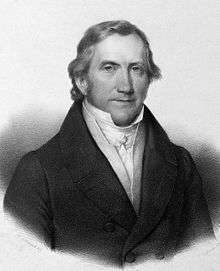Franz Naegele
Franz Karl Naegele (7 December 1778 – 21 January 1851) was a German obstetrician born in Düsseldorf. His son, Hermann Franz Naegele (1801–1851), was also a noted obstetrician.[1]

Franz Naegele
He earned his medical degree from the University of Bamberg, afterwards opening a medical practice in Barmen. In 1807, he became an associate professor at the University of Heidelberg, where in 1810 he was appointed a full professor of obstetrics.
He is remembered for "Naegele's rule", a standard method of calculating the due date for a pregnancy. His name is also lent to "Naegele obliquity", also known as an anterior asynclytism.[2]
Selected publications
- Beytrag zu einer naturgeschichtlichen Darstellung der krankhaften Erscheinung am thierischen Körper, welche man Entzündung nennt, und ihre Folgen. Dänzer, Düsseldorf 1804. Digitalization by the University of Düsseldorf
- Erfahrungen und Abhandlungen aus dem Gebiethe der Krankheiten des weiblichen Geschlechtes. Mannheim: Tobias Loeffler. 1812.
- Über den Mechanismus der Geburt. Heidelberg. 1822. Translated into English by Edward Rigby in 1829 as An Essay on the Mechanism of Parturition.
- Das Weibliche Becken: betrachtet in Beziehung auf seine Stellung und die Richtung seiner Höhle: nebst Beyträgen zur Geschichte der Lehre von den Beckenaxen. Karlsruhe: Chr. Fr. Müller. 1825.
- Katechismus der Hebammenkunst: als Anhang zu seinem Lehrbuche der Geburtshülfe für die Hebammen : für Lehrende und Lernende (3rd ed.). Heidelberg: J.C.B. Mohr. 1836.
- Das schräg verengte Becken; nebst einem Anhange über die wichtigsten Fehler des weiblichen Beckens. (1839); translated into English in 1939 as "The obliquely contracted pelvis, containing also an appendix of the most important defects of the female pelvis".
- Lehrbuch der Geburtshülfe (1843) – Textbook of midwifery.[3]
- "Ein Briefwechsel zwischen Joseph Alexis Stoltz und Franz Carl Naegele der XIII.: Versammlung der deutschen Gesellschaft für Gynäkologie 2.-5. Juni 1909 zum Empfang gewidmet von der Universitätsfrauenklinik Straßburg I. Els". J.H. Heitz, 1909 (Letters to and from Joseph-Alexis Stoltz)
gollark: Imagine not using hair spaces.
gollark: Why should it *not* work? If I'm flying intercontinentally, I would be annoyed if I couldn't just open up Rust and Rust some Rust.
gollark: I license all my things under MIT because who could possibly profit off them ever.
gollark: If you don't have *some* concessions to text it'll probably end up very impractical and you'll need 129401749712 keybindings for "infix operation" or whatever and it'll be hard to move code around.
gollark: ALL is Lisp except nonlisp things.
References
- ADB Deutsche Biographie
- Klinkhammer, Gisela. Ärztetags-Sonderstempel: Zu Ehren von Franz Karl Naegele Dtsch Arztebl 2001; 98(22): [84] / [84] / [84] (in German)
- Archived 2013-01-27 at Archive.today Medical History Museum Ancient instruments and equipment
- Google Books, Essential of Obstetrics By Arulkumaran
- Yufind library, Yale University
This article is issued from Wikipedia. The text is licensed under Creative Commons - Attribution - Sharealike. Additional terms may apply for the media files.